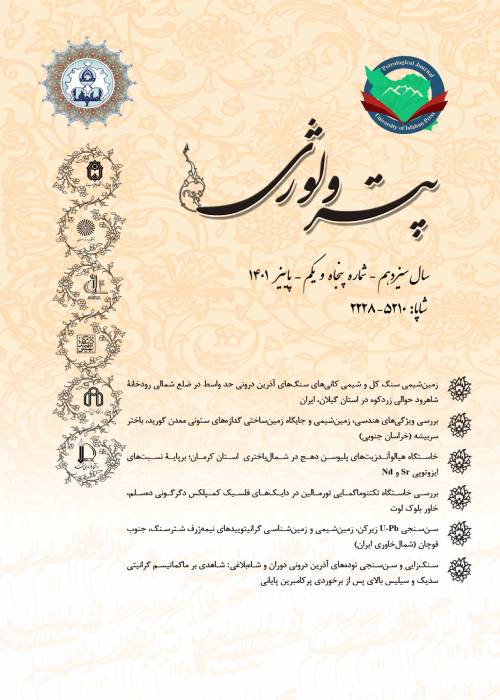Magmatism of northwest of Takestan: The product of asymmetric caldera collapse
One of the main products of caldera collapses is ignimbrite, and there is a direct relationship between the volume of ignimbrite and caldera dimensions. During caldera collapse, a large volume of magma is explosively discharged as products and pyroclastic flows (Druitt and Sparks, 1984). Lava domes and cones are placed along or inside the caldera rim structures after the collapse (Aguirre-Díaz, 1996). The studied area, in the northwest of Takestan, is a part of the Alborz and Western Alborz magmatic arcs, which consisting of some granitoid rocks, volcanic units, dacitic and rhyolitic domes as well as pyroclastic units. The presence of ignimbrite and dacitic and rhyolitic domes along with mafic volcanic rocks and intrusive rocks show the occurrence of the caldera in the region.In the Alborz and Urumieh-Dokhtar belts, extensive volcanic eruptions occurred in the Eocene. The studied area lies in the western Alborz zone. The first studies of stratigraphy and classification of the Paleogene volcanic and intrusive rocks in western Alborz are related to Taleghan and Qazvin regions (Annells et al., 1975). The dominant feature in the northwest of Takestan is pyroclastic deposits, lava flows, and intrusive and sub-volcanic rocks. Volcanic rocks and lava flows are placed on the tuffs with a more limited expansion. Sub-volcanic rocks are in the form of dacitic and rhyolitic domes and intrusive rocks intruded the tuffs.
Method of study:
In this research, about 120 samples of different volcanic, intrusive, and pyroclastic rocks are gathered, then 56 thin sections were prepared and studied. To measure the main and rare elements, 29 suitable samples including 16 fresh samples of intrusive rocks and 13 volcanic samples were selected and analyzed using ICP-OES and ICP-MS at Zarazma Minerals Studies Laboratory in Tehran.
Volcanic rocks are rhyolite, dacite, andesite, trachyandesite, basaltic andesite, and basalt, with porphyry texture and a glassy or microlitic groundmass. Evidences such as the presence of ocelli quartz, plagioclases with sieve texture and the formation of a thin layer of fine pyroxenes at the edge of some pyroxenes show that the basaltic and basaltic andesitic rocks are contaminated with crustal compounds or mixed with crustal melts. The intrusive rocks are alkaline granite, granite, quartz monzonite, quartz monzodiorite, and monzodiorite, which often have a granular texture. The absence of muscovite and hypersolvus feldspars in alkaline granites and quartz monzonites confirms that these granites are anorogenic (Kleemann and Twist, 1989).
Whole rocks chemistry:
Basic to felsic members are seen in both intrusive and volcanic groups. The range of SiO2 changes from 53.52-75.23% for intrusive rocks and 51.11-74.8% for volcanic rocks. MgO is 0.19-4.66% for intrusive rocks and 0.24-4.18% for volcanic rocks, and Al2O3 is 10.22 and 17.2% for intrusive rocks and 10.24 and 16.66% for volcanic rocks. According to Irvine and Baragar (1971) diagram, volcanic samples and most of the intrusive samples are sub-alkaline. In AFM ternary diagram, volcanic and intrusive samples have a calc-alkaline trend.
Petrogenesis Trace elements variation diagrams show two groups with two separate trends in the volcanic rocks. The first group (rhyolites and some dacites) show the fractional crystallization trend, but the second group (andesite basalts and andesites and some dacites) demonstrate the partial melting trend. This phenomenon can also indicate the different origins of these rocks. Intrusive rocks are also divided into two groups with a parallel trend, which have a dominant trend of fractional crystallization trend, and probably these two groups also have different origins. The spider diagrams show that all the samples are enriched concerning the primary mantle. Some of the anomalies observed in these diagrams indicate that these rocks originated in subduction zone. Crustal contamination or extensive melting of crustal materials occurred in the region. Genetic classification of granitoids and tectonic setting Discrimination diagrams show that the samples of monzodiorite and quartz monzonites are I-type and alkaline granites are A-type (subgroup A2). According to the tectonic setting diagrams, except for some alkaline granites, the other samples are in the field of volcanic arc setting rocks. Alkaline granites and rhyolites are related to the post-orogenic setting, quartz monzonitic samples are related to the late orogenic setting, and granites are located in the range between these two groups. The dacitic samples are located in the syn-collision to late orogeny environments. Acidic volcanic and intrusive samples are the melting results of amphibolites (some dacites and quartz monzonites) and some others are probably melting result of the metagraywakes (rhyolites, some dacites, and alkali granites). Basalt, basaltic andesite, and monzodiorite to monzogabbro, are product of mantle melting in the volcanic arc and rhyolite, dacite, alkali granite, and quartz monzonite, are the result of crustal melting.
Caldera formation:
The presence of ignimbrite units, dacitic and rhyolitic domes with a semi-circular arrangement in the east of the intrusive rocks, and co-ignimbrite breccias, reveal the possibility of caldera formation in the region. Considering the relatively less amount of ignimbrites, the dimensions of the formed caldera were probably small. The presence of dacitic and rhyolitic domes on one side of the intrusive rocks shows that the type of caldera is trap-door type.
- حق عضویت دریافتی صرف حمایت از نشریات عضو و نگهداری، تکمیل و توسعه مگیران میشود.
- پرداخت حق اشتراک و دانلود مقالات اجازه بازنشر آن در سایر رسانههای چاپی و دیجیتال را به کاربر نمیدهد.




